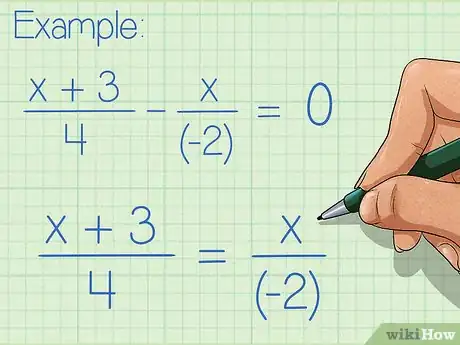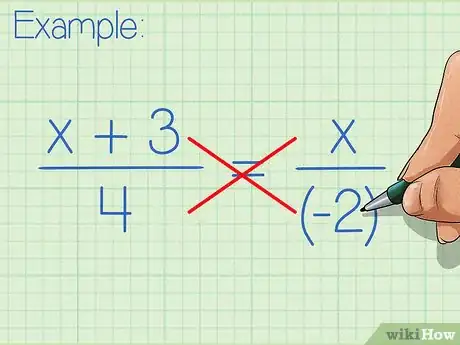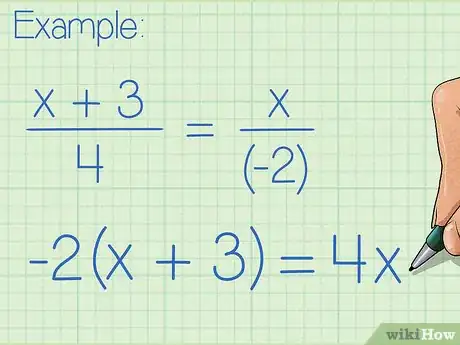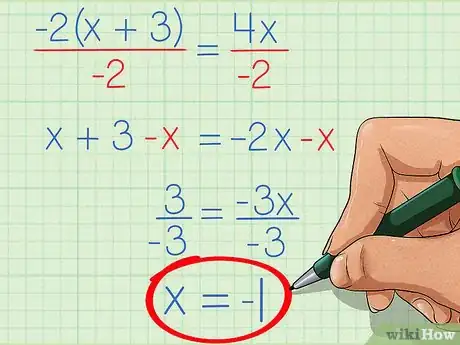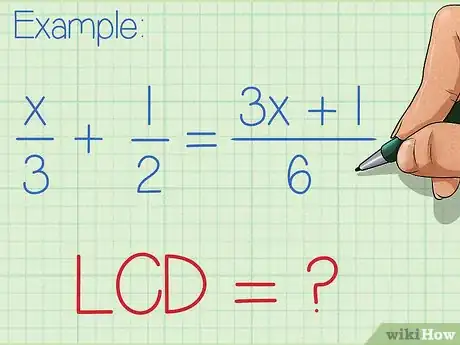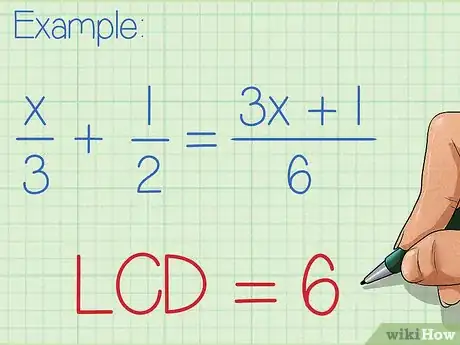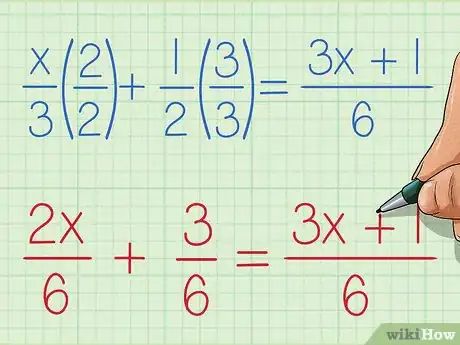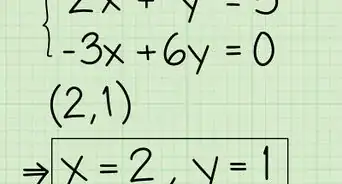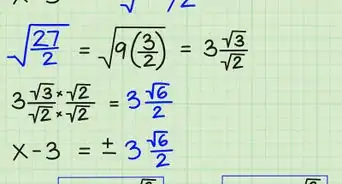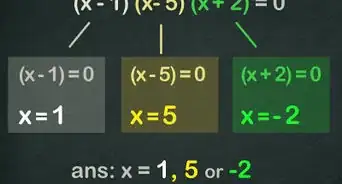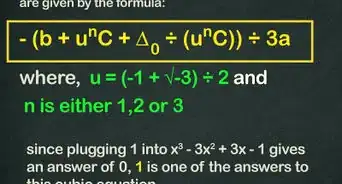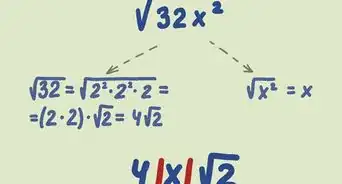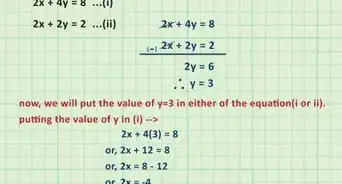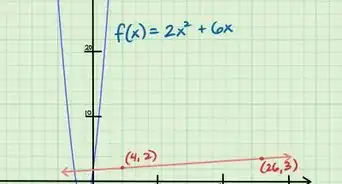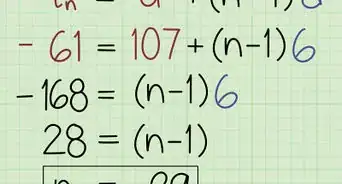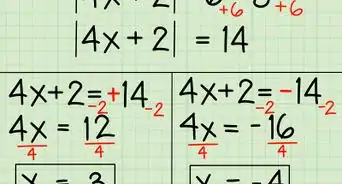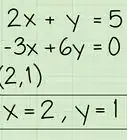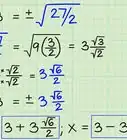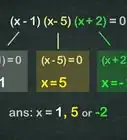wikiHow is a “wiki,” similar to Wikipedia, which means that many of our articles are co-written by multiple authors. To create this article, 12 people, some anonymous, worked to edit and improve it over time.
This article has been viewed 129,264 times.
Learn more...
A rational expression is a fraction with one or more variables in the numerator or denominator. A rational equation is any equation that involves at least one rational expression. Like normal algebraic equations, rational equations are solved by performing the same operations to both sides of the equation until the variable is isolated on one side of the equals sign. Two special techniques, cross multiplication and finding lowest common denominators, are extremely useful for isolating variables and solving rational equations.
Steps
Cross Multiplying
-
1If necessary, rearrange your equation to get one fraction on each side of the equals sign. Cross-multiplication is a quick, easy way of solving rational equations. Unfortunately, this method only works for rational equations that contain exactly one rational expression or fraction on each side of the equals sign. If your equation isn't in proper cross-multiplication form, you may need to use algebraic operations to move its terms into their proper places.[1]
- For instance, the equation (x + 3)/4 - x/(-2) = 0 can easily be rearranged into cross-multiplication form by adding x/(-2) to both sides of the equation, leaving you with (x + 3)/4 = x/(-2).
- Keep in mind that decimals and whole numbers can be made into fractions by giving them a denominator of 1. (x + 3)/4 - 2.5 = 5, for instance, can be rewritten as (x + 3)/4 = 7.5/1, making it a valid candidate for cross-multiplication.
- Some rational equations can't easily be reduced into a form with one fraction or rational equation on each side of the equals sign. In such cases, use a lowest common denominator approach.
- For instance, the equation (x + 3)/4 - x/(-2) = 0 can easily be rearranged into cross-multiplication form by adding x/(-2) to both sides of the equation, leaving you with (x + 3)/4 = x/(-2).
-
2Cross-multiply. Cross-multiplication simply means multiplying one fraction's numerator by the other's denominator and vice versa. Multiply the numerator of the fraction on the left of the equal sign by the denominator of the fraction on the right. Repeat with the numerator of the right-hand fraction and the denominator of the fraction on the left.[2]
- Cross-multiplication works according to basic algebraic principals. Rational expressions and other fractions can be made into non-fractions by multiplying them by their denominators. Cross-multiplication is basically a handy shortcut for multiplying both sides of the equation by both fraction's denominators. Don't believe it? Try it - you'll get the same results after simplifying.
Advertisement -
3Set the two products as equal to each other. After cross-multiplying, you'll have two products. Set these two terms equal to each other and simplify to get each side of the equation in its simplest terms.[3]
- For example, if your original rational expression was (x+3)/4 = x/(-2), after cross multiplying, your new equation is -2(x+3) = 4x. If we wish, this can also be written as -2x - 6 = 4x.
-
4Solve for your variable. Use algebraic operations to solve for the variable in your equation. Remember that, if x appears on both sides of the equals sign, you'll need to add or subtract x terms to both sides to get x terms on only one side of the equals sign.[4]
- In our example, we can divide both sides of the equation by -2, giving us x+3 = -2x. Subtracting x from both sides gives us 3 = -3x. Finally, dividing both sides by -3 gives us -1 = x, which we can re-write as x = -1. We have found x, solving our rational equation.
Finding a Lowest Common Denominator (LCD)
-
1Know when finding a Lowest Common Denominator is appropriate. Lowest Common Denominators (LCD's) can be used to simplify rational equations, making it possible to solve for their variables. Finding an LCD is a good idea when your rational equation can't easily be written in a form that has one (and only one) fraction or rational expression on each side of the equals sign. For solving rational equations with three terms or more, LCD's are a helpful tool. However, for solving rational equations with only two terms, cross-multiplication can be faster.[5]
-
2Examine the denominator of each fraction. Identify the lowest number that each denominator divides into evenly. This is the LCD for your equation.[6]
- Sometimes the lowest common denominator - that is, the lowest number that has each of the existing denominators as a factor - is obvious. For example, if your expression is x/3 + 1/2 = (3x+1)/6, it's not hard to see that the smallest number with 3, 2 and 6 as a factor, is, in fact, 6.
- Often, however, a rational equation's LCD isn't immediately obvious. In these cases, try examining multiples of the larger denominator until you find one that contains all of the smaller denominators as a factor. Often, the LCD is a multiple of two of the denominators. For example, in the equation x/8 + 2/6 = (x - 3)/9, the LCD is 8*9 = 72.
- If one or more of your fractions' denominators contains a variable, this process is more involved, but not impossible. In these cases, the LCD will be an expression (containing variables) that all the denominators divide into, not a single number. For example, in the equation 5/(x-1) = 1/x + 2/(3x), the LCD is 3x(x-1), because each denominator divides into it evenly - dividing it by (x-1) gives 3x, dividing it by 3x gives (x-1), and dividing it by x gives 3(x-1).
-
3Multiply each fraction, in the rational equation by 1. Multiplying each term by 1 may seem pointless. However, there's a trick. 1 can be defined as any number over itself - 2/2 and 3/3, for example, are also valid ways of writing "1." This method takes advantage of this alternate definition. Multiply each fraction in your rational equation by 1, writing 1 each time as the number or term which multiplies with each denominator to give the LCD over itself.[7]
- In our basic example, we would multiply x/3 by 2/2 to get 2x/6 and multiply 1/2 by 3/3 to get 3/6. 3x +1/6 already has 6, the LCD, as its denominator, so we can either multiply it by 1/1 or leave it alone.
- In our example with variables in the denominators of our fractions, the process is slightly trickier. Since our LCD is 3x(x-1), we multiply each rational expression by the term which it multiplies with to give 3x(x-1) over itself. We would multiply 5/(x-1) by (3x)/(3x) giving 5(3x)/(3x)(x-1), multiply 1/x by 3(x-1)/3(x-1) to give 3(x-1)/3x(x-1), and multiply 2/(3x) by (x-1)/(x-1) to give 2(x-1)/3x(x-1).
-
4Simplify and solve for x. Now that every term in your rational equation has the same denominator, you can eliminate the denominators from the equation and solve the numerators. Simply multiply both sides of the equation to get your numerators by themselves. Then, use algebraic operations to get x (or whatever other variable you are solving for) alone by itself on one side of the equals sign.[8]
- In our basic example, after multiplying every term by alternate forms of 1, we get 2x/6 + 3/6 = (3x+1)/6. Two fractions can be added together if they have the same denominator, so we can simplify this equation as (2x+3)/6 = (3x+1)/6 without changing its value. Multiply both sides by 6 to cancel the denominators, which leaves us with 2x+3 = 3x+1. Subtract 1 from both sides to get 2x+2 = 3x, and subtract 2x from both sides to get 2 = x, which can be written as x = 2.
- In our example with variables in the denominators, our equation after multiplying each term by "1" is 5(3x)/(3x)(x-1) = 3(x-1)/3x(x-1) + 2(x-1)/3x(x-1). Multiplying each term by our LCD allows us to cancel the denominators, giving us 5(3x) = 3(x-1) + 2(x-1). This works to 15x = 3x - 3 + 2x -2, which simplifies to 15x = x - 5. Subtracting x from both sides gives 14x = -5, which, finally, simplifies to x = -5/14.
Community Q&A
-
QuestionHow do I solve 5/4x+1/x=3?
 DonaganTop AnswererSolve for x by multiplying both sides of the equation by 4x to get rid of the fractions: 4x(5/4x + 1/x) = 4x(3). Then 5 + 4 = 12x, 9 = 12x, and x = 9/12 = ¾.
DonaganTop AnswererSolve for x by multiplying both sides of the equation by 4x to get rid of the fractions: 4x(5/4x + 1/x) = 4x(3). Then 5 + 4 = 12x, 9 = 12x, and x = 9/12 = ¾. -
QuestionHow do I do, 6x=5-3/4?
 DonaganTop AnswererIf the equation is 6x = 5 - ¾, all you have to do to solve for x is to divide both sides of the equation by 6: 6x = 4¼ = 17/4. Divide by 6: x = 17/24.
DonaganTop AnswererIf the equation is 6x = 5 - ¾, all you have to do to solve for x is to divide both sides of the equation by 6: 6x = 4¼ = 17/4. Divide by 6: x = 17/24. -
QuestionHow do I solve this rational equation? x+3 / x-3 + x+5 / x-5 = x+5 / x-5
 DonaganTop AnswererFrom both sides of the equation subtract [(x+5)/(x-5)]. That leaves [(x+3)/(x-3)] = 0. Multiply both sides of the equation by (x-3). That gives you (x+3) = 0. Therefore, x = -3.
DonaganTop AnswererFrom both sides of the equation subtract [(x+5)/(x-5)]. That leaves [(x+3)/(x-3)] = 0. Multiply both sides of the equation by (x-3). That gives you (x+3) = 0. Therefore, x = -3.
References
- ↑ https://pressbooks.bccampus.ca/algebraintermediate/chapter/solve-rational-equations/
- ↑ https://flexbooks.ck12.org/cbook/ck-12-algebra-ii-with-trigonometry-concepts/section/9.14/primary/lesson/solving-rational-equations-using-cross-multiplication-alg-ii/
- ↑ https://www.purplemath.com/modules/solvrtnl.htm
- ↑ https://www.purplemath.com/modules/solvrtnl.htm
- ↑ https://flexbooks.ck12.org/cbook/ck-12-elementary-intermediate-college-algebra/section/9.7/primary/lesson/solving-rational-equations-using-cross-multiplication-c-alg/
- ↑ https://www.chilimath.com/lessons/advanced-algebra/solving-rational-equations/
- ↑ https://pressbooks.bccampus.ca/algebraintermediate/chapter/solve-rational-equations/
- ↑ https://www.chilimath.com/lessons/advanced-algebra/solving-rational-equations/
- http://tutorial.math.lamar.edu/Classes/Alg/RationalExpressions.aspx
About This Article
To solve a rational equation, start by rearranging it so you have 1 fraction on each side of the equals sign. Then, cross multiply by multiplying the first fraction's numerator by the second fraction's denominator, and vice versa. Next, set the 2 products equal to each other and simplify them. Finally, solve the equation by solving for the variable. To learn how to solve a rational equation by finding the lowest common denominator, scroll down!
